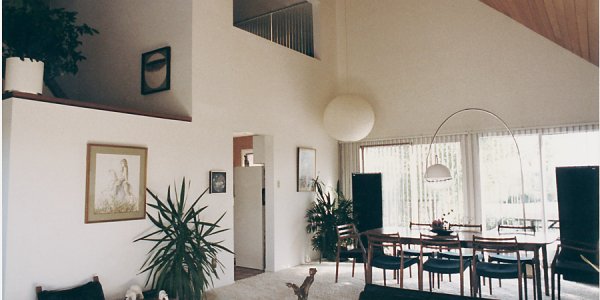Your previous home had a completely asymmetrical situation with a ceiling that was slanted from left to right. How bad was that Steve?His acoustician has OEM products that are much better that provides the best solutions
Ceiling Acoustics Question
- Thread starter Ron Resnick
- Start date
You are using an out of date browser. It may not display this or other websites correctly.
You should upgrade or use an alternative browser.
You should upgrade or use an alternative browser.
What sounded wrong about it?It was far from ideal. Next question
Come again? You had an asymmetrical configuration. That is what Ron is asking about. What about that is off-topic?Stay on topic or stay out of the thread.
Absorption is the right solution to asymmetry. It would have to be broadband which means at least 4 to 5 inches thick.
Diffusion sends those waves to other places. I suspect what comes out from the top of your speaker does not have good timbre compared to what comes out from the front. So I would not use diffusion even though it will look much prettier.
The above assumes you have not created a very dead room already. If you have, then adding more to it on the ceiling would make it even more dead.
Here is what I suggest Ron. Do as MikeL has done. Get a temporary thick pillow and tape it to the ceiling and listen. If it improves things, then you are golden. If not, leave it alone. The psychoacoustics of what you have is quite complex. The ears are the right tool to analyze acoustics above a few hundred hertz.
Thank you, Amir.
Come again? You had an asymmetrical configuration. That is what Ron is asking about. What about that is off-topic?
Good question. I don't understand it either.
BTW, thanks, Amir, for the info as well.
I appreciate the suggestions of each of you, but is there really no consensus as to whether absorption or diffusion more successfully makes a section of wall or a section of ceiling "disappear" acoustically -- as though such section of wall or ceiling were literally not there?
Dear Ron,
You're asking for a magic bullet where none exist and from people who've never been in your room, I wouldn't go with any concensus from here even if there was one! You have a serious structural issue here and nothing you do is going to fix that with 7' tall speakers, in fact it's possible that you'd make things worse trying to treat it, a lot worse! You're already familiar with your room and the extent of the problem more than anyone else. I can tell you from experience that if its not major a good acoustician can come up with better compromises, you have to discuss it with that person and figure out which approach suits your personal tastes better. If your ceiling is a major obstacle then it's prudent to take a deep breath, accept reality and look for speakers that won't be affected as much by the ceiling height.
david
Those worried with asymmetrical tilted ceilings should read this article https://www.audioholics.com/room-acoustics/room-reflections-human-adaptation/image_view_fullscreen and regain peace of mind  - the figure shows the listening room of Floyd Toole in the late 80's.
- the figure shows the listening room of Floyd Toole in the late 80's.
Attachments
Absorption is the right solution to asymmetry. It would have to be broadband which means at least 4 to 5 inches thick.
Diffusion sends those waves to other places. I suspect what comes out from the top of your speaker does not have good timbre compared to what comes out from the front. So I would not use diffusion even though it will look much prettier.
The above assumes you have not created a very dead room already. If you have, then adding more to it on the ceiling would make it even more dead.
Here is what I suggest Ron. Do as MikeL has done. Get a temporary thick pillow and tape it to the ceiling and listen. If it improves things, then you are golden. If not, leave it alone. The psychoacoustics of what you have is quite complex. The ears are the right tool to analyze acoustics above a few hundred hertz.
Broadband at what frequency range Amir? I haven't come across any materials that's evenly absorptive across a broad range when dealing with middle and lower frequencies and just absorbing the top end will mess with the over all balance of the sound. Diffusion might be the right approach in his room, you can't say until you've been there and know exactly what you're dealing with.
Regarding the the pillow test, Mike's situation is very different he's fine tuning a purpose built dedicated listening room that he's had for years and is intimately familiar with. Ron has a major structural problem, in his living room, what's a little pillow going to tell him?
david
Those worried with asymmetrical tilted ceilings should read this article https://www.audioholics.com/room-acoustics/room-reflections-human-adaptation/image_view_fullscreen and regain peace of mind- the figure shows the listening room of Floyd Toole in the late 80's.
Problem isn't asymmetry, it's the one foot clearance on one side in Ron's case that may or may not cause a problem with his speakers but it could come into play. Given the ceiling heights in this picture they don't matter, unless of course they create a situation with overall ratios. The only thing I'm certain of from this picture is that sound quality and optimal speaker placement wasn't a priority here...
david
Last edited:
In acoustics, broadband means above schroeder transition frequencies. For home spaces, this is usually in the 200 to 300 Hz. Here is what a 4 inch absorber looks like:Broadband at what frequency range Amir? I haven't come across any materials that's evenly absorptive across a broad range when dealing with middle and lower frequencies and just absorbing the top end will mess with the over all balance of the sound.

As you see, above a few hundred hertz, it is a very effective and uniform absorber.
Getting diffusion which works broadband is even harder than absorbers:Diffusion might be the right approach in his room, you can't say until you've been there and know exactly what you're dealing with.

As to not being able to tell him until being there, that is not so. As I explained if you want asymmetry to go away which is what Ron asked, the solution is an absorber. A diffuser would create a very different environment on that channel than what is going on, on the other channel.
Now whether anything is needed is another question. I am simply giving Ron the technical answer.
I don't buy what you say about Mike. It doesn't matter though. I simply offered that Ron can experiment with something like this and hear it for himself. It doesn't matter if he knows or doesn't know his room. He can put the panel up or a replacement absorber and see what difference it makes.Regarding the the pillow test, Mike's situation is very different he's fine tuning a purpose built dedicated listening room that he's had for years and is intimately familiar with. Ron has a major structural problem, in his living room, what's a little pillow going to tell him?
david
Looking around I could not find any listening room with full absorption at the ceiling or someone endorsing full absorption on the ceiling - on the contrary many people use reflectors or diffusers in the ceiling.
The few references about fully absorbing ceiling primary reflections come from the people advising on how to built control rooms. What are the subjective consequences of such approach?
The few references about fully absorbing ceiling primary reflections come from the people advising on how to built control rooms. What are the subjective consequences of such approach?
Ceilings produce reflections too. In almost all rooms there will be an Allison effect null from the ceiling at the listening position. This is just like a floor bounce. IME, these very narrow band nulls are less of a problem than one might think. But it would pay dividends to measure with a mic since the phenomenon will be low frequency.
Acousticians frequently spec absorption on the ceiling. I personally modified a ceiling cloud with some diffusion on the surface so it is able to diffuse and absorb the importent frequencies. It works well but it cannot totally eliminate the low frequency reflection.
Ron's choice of speaker may mean this really isn't much of an issue. It would be helpful to see a mic measurement Ron.
Acousticians frequently spec absorption on the ceiling. I personally modified a ceiling cloud with some diffusion on the surface so it is able to diffuse and absorb the importent frequencies. It works well but it cannot totally eliminate the low frequency reflection.
Ron's choice of speaker may mean this really isn't much of an issue. It would be helpful to see a mic measurement Ron.
Looking around I could not find any listening room with full absorption at the ceiling or someone endorsing full absorption on the ceiling - on the contrary many people use reflectors or diffusers in the ceiling.
The few references about fully absorbing ceiling primary reflections come from the people advising on how to built control rooms. What are the subjective consequences of such approach?
It is helpful if rooms are symmetrical so that the reflections are consistent between right and left speakers. However, asymmetrical setups can produce excellent results too.
Lately, I've been experimenting with with IACC (inter aural cross correlation) as a helpful guide to speaker and listener repositioning. Acourate can measure IACC in a listening position measurement. IME I've found the higher IACC value to correlate with better stereo image and spaciousness. It's funny because the best IACC result in my room is measured when I move the seated position and speaker position slightly off center, even though my room is mostly symmetrical.
Lately, I've been experimenting with with IACC (inter aural cross correlation) as a helpful guide to speaker and listener repositioning. Acourate can measure IACC in a listening position measurement. IME I've found the higher IACC value to correlate with better stereo image and spaciousness. It's funny because the best IACC result in my room is measured when I move the seated position and speaker position slightly off center, even though my room is mostly symmetrical.
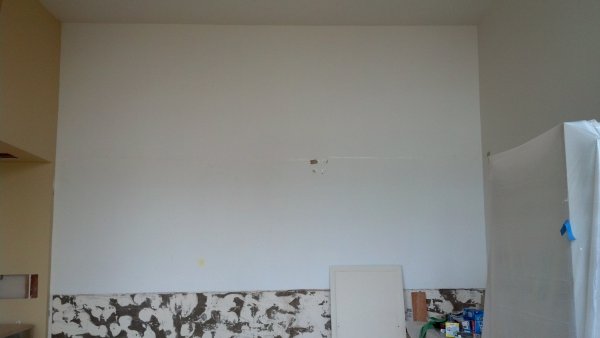
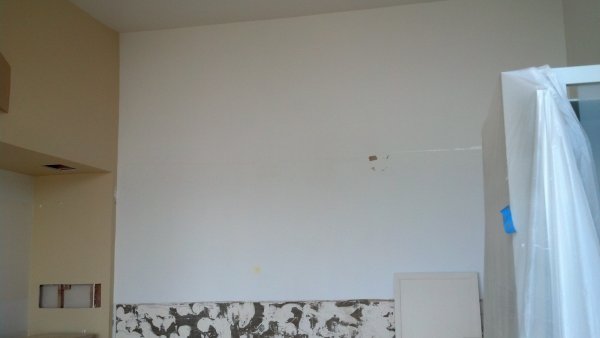
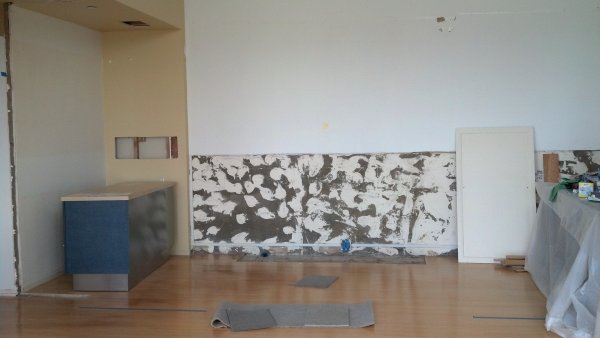
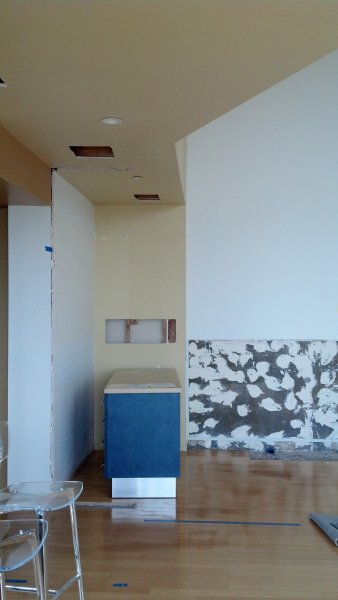
I apologize for not taking and posting photos originally to make clear what I am asking about.
The blue tape on the floor shows approximately where wide speakers would be positioned. You can see how part of the left speaker would be under the lower (9') ceiling height.
I, personally, do not think having part of the left speaker underneath the 9' drop-down ceiling height is going to be a big deal, but there certainly is the opportunity to put absorptive or diffusive acoustic material on the 9' drop-down ceiling right above the left speaker, if desirable.
Looking around I could not find any listening room with full absorption at the ceiling or someone endorsing full absorption on the ceiling - on the contrary many people use reflectors or diffusers in the ceiling.
The few references about fully absorbing ceiling primary reflections come from the people advising on how to built control rooms. What are the subjective consequences of such approach?
Here:
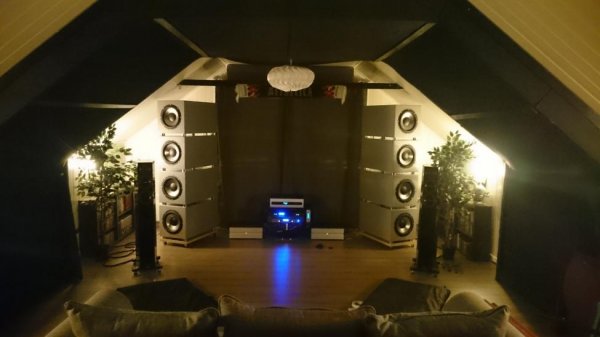
My room has a half angled ceiling on the left, (see system pic http://www.whatsbestforum.com/album.php?albumid=68&attachmentid=5391), and the REW frequency response from the left and right sides are almost identical. The left side has a narrow slight dip at 40 Hz and the right side has a narrow slight dip at 45 Hz and the right side has a narrow 2 dB dip at 300 Hz that is not present on the left. All in all, the system is very flat from 10Hz to 20kHz and I can't say that specifically the ceiling is making as much of a difference between channels compared to the left wall being glass and the right wall being one inch thick hard pine over sheetrock. Still, both sides have a very similar room frequency response and it sounds very musical.
Last edited:
Similar threads
- Replies
- 74
- Views
- 6K
- Replies
- 5
- Views
- 547
- Replies
- 37
- Views
- 2K
Staff online
-
treitz3Super Moderator
Members online
- rdg
- tsaett
- justubes
- Hermanh
- Maril555
- itay123
- Another Johnson
- moby2004
- PierreB
- mtakeda
- thekong
- 3rdRock
- Ravel
- SlapEcho
- JeremyMTB
- Mikeeo
- Aries Cerat
- Rexp
- jazzdude99
- hopkins
- schlager
- JGlacken
- bonzo75
- acousticsguru
- RCanelas
- jpwelcher
- audiolab
- LarryK
- dctom
- Rob77
- Bjorn
- wbfhet
- Geoffkait
- trekpilot
- ozy
- matthias
- Lyubo
- earlinarizona
- GHasley
- Azjya
- kodomo
- jaxdr
- rlevden
- treitz3
- andromedaaudio
- ariess
- Salectric
- dminches
- pjwd
- kyoya78
Total: 1,319 (members: 71, guests: 1,248)
| Steve Williams Site Founder | Site Owner | Administrator | Ron Resnick Site Co-Owner | Administrator | Julian (The Fixer) Website Build | Marketing Managersing |













